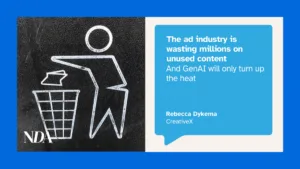By Ralf Paschen, CMO at xtype.io
It’s never been harder to grab attention. I don’t just mean in terms of attention spans, though people certainly believe it’s harder to concentrate these days: 49% of people feel like their attention span is shorter than it used to be, while 47% say that “deep thinking” has become a thing of the past.
What I also mean is standing out. More companies are generating more content at a faster rate. As a start-up, it can be daunting even to consider trying to stand out, particularly when competing for the same eyeballs and share of wallet as much larger organizations with bigger marketing teams and budgets.
Why are you trying to stand out?
But before we get caught up in finding ways to stand out from the crowd, it is worth interrogating exactly why we want to stand out. Ask ten people from across a business what marketing does, and you’ll no doubt get 12 different answers, at a minimum. Raise profile, promote the business, advertise, communicate what products do, get messages out, engage with customers, generate leads for sales, run social media, build websites, produce whitepapers, make t-shirts and other merchandising to give away at events.
And all of those things can be a part of marketing’s tactics. But its real role? To drive value back to the business. Without that, marketing, or indeed any function, is just a cost to the company. So, ultimately, if you’re in marketing, everything you do needs to be about driving value for the company. You might well be making t-shirts or organizing event giveaways, and that’s all good if you can demonstrate how you drive value.
That’s the sticking point, particularly in the B2B sphere: how do you demonstrate how you’ve driven value? It’s as hard for finance and customer support as it is for marketing, which is why you see so much of B2B marketing tying itself to lead generation. If you can generate X number of leads through Y activity, and eventually Z of those leads turn into sales, then you can claim something of that as proof of your value.
Why leads are the wrong metric
The thing is, focusing on leads is the wrong metric. Let me tell you a secret: I used to work in sales, and in a decade on that side of the fence, I didn’t get a single qualified lead from marketing. Not one.
What do I mean by a qualified lead? One that I could look at in whatever CRM system we were using and understand everything I needed to nurture that lead and turn it into a deal.
So, when I hear marketing teams talk about how many leads they generate, I switch off. Who cares if your campaign, with its gated whitepaper, captured 500 leads? I want to know how you qualified them and how rigorous that qualification was. Did you stop at job titles or find out whether they were a decision-maker, budget holder, or influencer? What’s their relationship with procurement? Where are they in their budget cycle and in their planning for next year? Do they even have the budget?
Good businesses are efficient, and start-ups must be more efficient than most. There’s no fat, no passengers. So if my sales team, which might only be two or three people strong, works on leads, I want to be sure that every minute of their day is put to good use. And that’s why those leads need to be highly qualified.
Time to get smart with better data
How does marketing do that? By getting smart about what we work on and, more importantly, what we don’t. Again, efficiency is critical here. Don’t spend time on things that don’t work. Try things, experiment, and don’t be afraid of failure, but if you fail, move on.
But how do you do that? With better data. Let’s go back to the gated whitepaper, a classic of B2B marketing. It’s been around since the beginning of contact forms and PDFs. But so much content is free; why would anyone pay, with their personal data, for something? And even if you get people handing over their contact details in exchange for your PDF, how do you know where they’ve read to or how engaged they were with the content? Did they download it to grab a statistic on the third page, or did they get to the bit about your product? You don’t, so when you try to contact them, you don’t really know what’s of interest to them.
We experimented once by gating a piece of content at different points—two pages in, four pages, ten pages, eighteen pages. People read up to the gate with every test, then clicked off. We had better luck by providing a contact form and call to action at the end of the content. That way, we knew that people had engaged to some degree in our content and, because of the type of content, had a better understanding of their knowledge level. From there, we could start to target our communications more effectively and build a more comprehensive picture of that person.
So, you’ve got to get that data and do so in a way that is valuable to your efforts. A lead that comes to us at the end of a piece of content already has significantly more context, and therefore potential value, than one that filled in the form before they could read a word we had written.
That data allows you to be more efficient. It informs the move fast, fail fast, learn fast principle that any marketing organization should embody. Combine that with the right tools that allow you to create content faster, disseminate it faster, and get feedback faster, and you’re in a much better position to scale effectively.
Scale to qualify
Do all that, and it doesn’t matter if you’re standing out from the crowd or by how much, as long as you’re reaching the people relevant to your business and can qualify them rigorously and quickly. In B2B, we’re never talking about huge levels of engagement. Five hundred leads from one piece of content might look good. Still, if small marketing and sales teams then have to manually qualify each of them to identify two or three, that will eventually get to that deal stage, then it’s highly inefficient. You want to be at a point where whether you get one lead or 5,000, you’ve got an automated, targeted content process that will provide contextualization and qualification long before a single employee looks at them.
That’s what we all need to be striving for in a crowded, noisy, and attention-phobic market.








